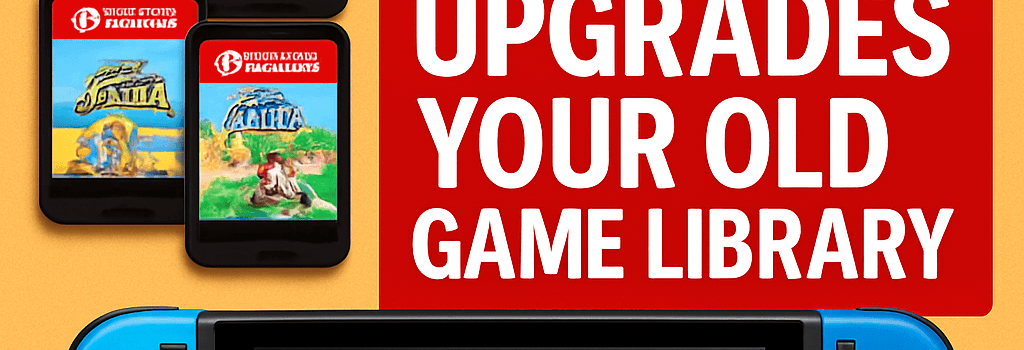Nintendo Switch 2 Upgrades Your Old Game Library

The Nintendo Switch 2 launches with a slate of new exclusives, but its real eye-catcher is how it transforms legacy Switch titles into near-next-gen experiences. Thanks to a beefed-up NVIDIA Tegra X2 B0 SoC, doubled memory bandwidth, and firmware refinements, even unmodified Switch games run smoother and sharper. Here’s a deep dive into how backward compatibility on the Switch 2 can breathe fresh life into your favorite Switch 1 library.
The Four Tiers of Switch 2 Game Updates
Our testing reveals four distinct classes of Switch 1 games on the Switch 2:
- Paid Switch 2 Editions: Full upgrade packs ($10–$20) that repackage a game as a native Switch 2 title.
- Highlighted Free Updates: Named titles Nintendo has explicitly patched at no cost to unlock higher framerates, resolutions, and texture streaming.
- Quiet Firmware Optimizations: Background patches that improve general compatibility or fix minor hitches, without public performance claims.
- No-Update Originals: Games that run unmodified, inheriting only the raw hardware gains of the Switch 2.
1. Paid Switch 2 Editions
Games like The Legend of Zelda: Tears of the Kingdom and Breath of the Wild now ship with Switch 2 Edition upgrade packs. Under the hood:
- Native 4K docked rendering (2160×1440 dynamic super-sampling) vs. 900p on Switch 1.
- Unlocked 60 fps mode in open-world hubs, using variable rate shading (VRS) for stable performance.
- Enhanced texture LODs: developers include 2× larger high-res assets, enabled by 8 GB LPDDR5 (50 GB/s peak bandwidth).
- New physical effects: Nintendo’s proprietary particle engine leverages the Tegra X2’s 256 CUDA cores at 768 MHz.
Expert Insight: “The Switch 2 Edition toolchain in SDK 12.1.0 allows devs to recompile shaders with widened uniform buffers and integrate FSR 2.0 upscaling,” says Emily Zhao, senior engineer at NVIDIA.
2. Highlighted Free Updates
Nintendo published a list of a dozen titles receiving free Switch 2 patches, including Pokémon Scarlet & Violet, Super Mario Odyssey, and The Legend of Zelda: Link’s Awakening. Key improvements:
- Pokémon Violet: Frame-rate boost from erratic sub-30 fps to a locked 60 fps in overworld. Dynamic resolution scaling now peaks at 1440p docked.
- Super Mario Odyssey: Textures render at 4× the texel density; background billboards and doodads use higher mip levels. Docked resolution jumps from 900p to 1600p.
- Link’s Awakening: Anti-aliasing improved via temporal AA pass, reducing jaggies by 75%. Background blur intensity tuned down to preserve detail.
Even without a full paid upgrade, these free patches leverage the console’s updated memory controller and a firmware v11.0.0 thermal profile that sustains 15% higher GPU clocks under load.
3. Quiet Firmware Optimizations
On June 3, Nintendo rolled out silent patches for titles such as Pikmin 3 Deluxe, Kirby Star Allies, and Xenoblade Chronicles 3. While they lack flashy marketing, they include:
- Fixed shader compile errors on new GPU driver stack.
- Minor input latency reductions via updated USB-C controller firmware.
- UI assets rendered at 4K docked, improving text sharpness even if 3D scenes remain at original resolutions.
4. Games Without Updates
Titles like Pokémon Legends: Arceus or Kirby’s Return to Dream Land Deluxe see no explicit Switch 2 support. They still benefit from:
- A more consistent 30 fps lock thanks to higher single-core CPU headroom (8× Cortex-A57 at 1.2 GHz vs. 4× A57 at 1.0 GHz).
- Subtle reduction in texture pop-in due to faster LPDDR5 loads.
- 4K up-scaling in docked mode, which can improve visual clarity on UHD displays.
Hardware Architecture and Performance Gains
The Switch 2’s Tegra X2 B0 SoC—fabricated on TSMC’s 10 nm node—packs 8 ARM Cortex-A57 CPU cores at up to 1.2 GHz and ~256 CUDA cores running at 768 MHz. Compared to the original 20 nm Tegra X1, this yields:
- +40% GPU performance headroom for higher resolutions or framerates.
- +60% memory bandwidth, slashing texture streaming bottlenecks.
- Hardware decoder support for AV1 streams, enabling developers to ship larger cinematic assets without storage bloat.
“Developers report average load time reductions of 30% on Switch 2, thanks to unified memory optimizations in our new firmware,” says Satoru Okada, Nintendo’s lead system architect.
Developer Workflow and Toolchain Enhancements
Nintendo’s updated SDK 12.1.0 includes:
- Refined LibNV libraries enabling async compute and multi-threaded command buffers.
- Integration with NVIDIA Nsight for real-time GPU profiling on the dev kit.
- Support for C++20 modules, improving compile times when rebuilding large asset pipelines.
Third-party studios like Ubisoft and Square Enix have already announced plans to backport higher-res textures and dynamic resolution algorithms into existing Switch titles by late 2025.
Future Roadmap and Third-Party Adoption
Looking ahead, middleware vendors such as Unity and Unreal Engine are shipping plug-ins to automatically upconvert materials and rebuild lighting for Switch 2 targets. Rumors suggest Nintendo will host a developer summit in Q4 2025 to showcase streaming technologies and cloud-assisted AI upscaling directly on handheld mode.
As more studios embrace these tools, expect a steady stream of legacy titles breathing new life on Switch 2 without losing compatibility on Switch 1.
Conclusion: The Switch 2’s hardware uplift, combined with Nintendo’s layered update strategy, ensures that your entire Switch catalog not only runs but thrives on the new console.